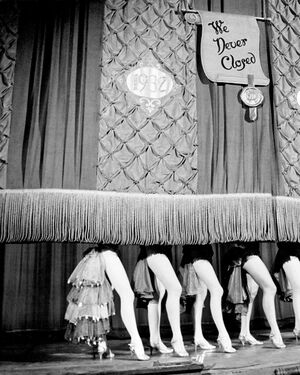‘Health and safety’ is generally taken to refer to physical safety. In various places at various times, the law has also sought to protect the public’s moral safety, as well as safeguarding the reputations of governments, monarchs and authorities.
Between 1932 and 1964, the Windmill Theatre in London’s Soho district presented variety performances, with singers, dancers, comedians, and showgirls. Initially it lost money, but the theatre soon found success when it began to present acts with glamorous nude women, based on the established shows at the Folies Bergère and Moulin Rouge in Paris. In Britain, the Theatres Act of 1843 banned the performance of plays if ‘it is fitting for the preservation of good manners, decorum or of the public peace so to do’, effectively outlawing nudity. The theatre argued that, since nude statues filled museums and art galleries, then presenting nude women on stage in static poses should also be permitted. It was on this basis the ‘Windmill Girls’ became famous, appearing on stage in a variety of tableaux vivants, following the rule: ‘if you move, it’s rude’.
The phrase ‘health and safety’ is generally used to refer to physical health and safety – preventing accidents and disease. However, alongside these physical protections, there is a much longer history of controls to protect the public from immoral and indecent content, and to protect the authorities from criticism. In Britain in 1737 the Licensing Act came into force to control and censor what was being said about the government through theatre. At a time when there was concern about the spread of revolutionary ideas and political uprisings, this act gave powers to the Lord Chamberlain – an official within the Royal household – to approve all plays before they were presented. It also created the office of the Examiner of Plays, who read the plays and advised on their content. The Examiner also had a responsibility to visit theatres, to ensure the safety and comfort of audiences, so linking physical safety with protecting the public (and of course the government) from dissenting voices.
The 1843 Theatres Act greatly limited the Lord Chamberlain’s powers of censorship, so that he could only ban plays for the ‘preservation of good manners, decorum or of the public peace’: censorship shifted its focus from protecting the government to protecting public morals. It was under the rules of the 1843 act that the shows at the Windmill Theatre took place. They used various strategies to attract audiences while staying within the letter of the law. A fan dance was introduced, in which the naked dancing girl and four clothed assistants held large fans of ostrich feathers to conceal the nudity during the dance, only removing the fans when the dancer held a static pose at the end. In another act, a stationary nude girl was suspended from a spinning rope – since it was the rope that was moving, not the girl, this was allowed by the authorities.
Censorship didn’t just apply to strip shows. In the post war era, playwrights increasingly wanted to address serious social and political concerns that reflected the rapid changes in society at the time but were finding themselves blocked by the Lord Chamberlain. Edward Bond’s play, Saved, showed a group of young people from an impoverished background, and included a scene in which a baby in a pram is stoned to death. When the play was submitted to the censor, changes and cuts were required which were unacceptable to the writer. In 1965 the play was presented as a private performance – a common means of avoiding censorship at the time – but those involved were still prosecuted and fined. The resulting public outcry against censorship from this incident and others like it led to the 1968 Theatres Act, which abolished the Lord Chamberlain’s role as censor.
Under the 1968 act, ‘obscene’ plays – those that might ‘deprave and corrupt’ those attending – and plays that might provoke a breach of the peace were still illegal. But the need to get plays approved in advance was gone. On the first night after the act came into force, the hippie counter-culture rock musical ‘Hair’ opened, featuring drugs, anti-war messaging and a small amount of nudity. The 1960s cultural revolution had finally reached the theatre stage.
Although legal censorship has largely gone, it continues in other, less well-defined ways. Funding authorities have an influence on artistic policy, while public protests lead to work being cancelled, such as the play Behzti (2004) and the live art installation Exhibit B (2014). In both cases, the makers responded to police guidance that to continue would create health and safety risks due to the likely protests that would follow. Suppression also operates through self-censorship: work that is not made, and things that are not said, by people who fear the consequences and so remain silent. In the early 2020s, the debate between people’s rights to be protected from offensive content versus the right to free speech is particularly strongly contested. In a time when physical safety in our theatres is perhaps better than it has ever been (I.09), and despite the abolition of censorship in 1968, the question of moral safety is as divisive as ever.
